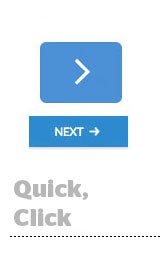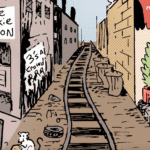 Here’s a scenario that has played out millions of times in recent months: A user clicks a Taboola or Outbrain link to arrive at a content page of marginal quality, such as the ViralWalrus.com slideshow “These 16 Celebs Served Real Jail Time.”
Here’s a scenario that has played out millions of times in recent months: A user clicks a Taboola or Outbrain link to arrive at a content page of marginal quality, such as the ViralWalrus.com slideshow “These 16 Celebs Served Real Jail Time.”
When the reader clicks the right arrow button to see the second page in a slideshow, however, they realize that, whoops, they’ve actually clicked on a Google AdSense text ad, featuring a prominent arrow graphic that looks remarkably like a “next” button of the sort commonly used in slideshow interfaces. These ads are placed in such a way that a careless consumer would click the ad and not the actual navigational button, which may be tucked away just a few hundred pixels below.
That user’s click initiates a transaction: The advertiser pays Google for the click. Google in turn pays out the publisher, keeping an undisclosed part for itself. That payout funds the publisher’s budget for future sourced traffic via content recommendation networks. The cycle continues.
The losers? Advertisers who end up paying for accidental clicks, users wasting their time and the industry as a whole, for perpetuating what most agree is a poor media experience.
In addition to ViralWalrus, sites like FrankiesFacts.com, TheMindCircle.com, Unmotivating.com, Buzz-Hut.com and DailyBananas.com place ad creative with arrow or play buttons adjacent to slideshow “next” buttons. There are dozens, or hundreds, of others like them.
AdExchanger set out to determine how some publishers, motivated by easy arbitrage money, are setting up these ads, as well as what Google and the content recommenders – arguably the enabling parties here – have to say about the practice.

Easy Money
Setting up an AdSense ad that replicates the appearance of a slideshow play button is simple for publishers in the know.
In their initial AdSense account set-up, these sellers will select “text-only” ads, not “text and image” ads. Doing so ensures that more arrow-shaped ads show up in their 728×90 slot. To make the ads look even more native, they customize them so the color of the arrow matches the color of their site. If the publisher puts the ad 70 pixels away from a place where a user legitimately clicks, it’s unlikely to run afoul of Google’s stated (but vague) policy that forbids placing ads where they’re likely to get accidental clicks.
The potential payout is high. Arrow ads in prominent (or misleading) places that generate a high CTR can command CPMs of $7 to more than $15. If the CTR is low, a publisher might only earn an 80-cent CPM, according to Jon Malach, a former publisher and CEO of Native Ads. That incentivizes misleading placements.
Many such “arbitrage publishers” operate under the radar. Several inquiries that AdExchanger submitted through “contact us” pages bounced. Often, sites pay extra to keep their domain registrations private, obfuscating the identity of the owners.
ViralWalrus attracted 2.8 million visitors in March, up from zero in December, according to SimilarWeb, which also shows that a large chunk of traffic was sourced to content recommendation networks Outbrain and Taboola. Its robust technology stack suggests the site was built by an expert. And yet, the publisher does not identify a single staff member, and an “About Us” link redirects to the home page.
Such publishers live in fear of being cut off by Google. If Google blacklists a publisher, taking all its revenue for the month after it’s already paid for that traffic, the publication can be on the hook for millions.
This happens with some frequency. Google often cuts off smaller publishers who suddenly exceed a 2% click-through rate, according to Malach, because it seems too high to be real.
He recalls frantically calling up his Google rep when a site in his network suddenly exceeded a 6% CTR. He was worried he would be banned.
The actual culprit? Google was testing a new ad format with a captivating, 3-D-like arrow graphic that users couldn’t help but click.
The reverse has happened too. Six weeks ago, for example, publishers that Malach works with saw AdSense CPMs fall off a cliff, because fewer arrow ads were hitting their sites – the result, according to the publishers’ Google reps, of efforts to reduce accidental ad clicks.
These optimization tweaks removed arrow ads within 100 pixels of a call to action, such as a “next” or “share” button. But the rules weren’t applied consistently, Malach reported. Once the “play button” creatives returned, higher CPMs did too.
The Buy Side
Most buyers have no idea their ads could end up in seedy online slideshows. They don’t even know how many arrow ads they’re running, as it’s just one of the many text ad formats that Google generates from the copy that a buyer submits when she sets up a campaign. Nor is the arrow ad new – it’s been kicking around for years.
While advertisers might still be in the dark, for years, smart search advertisers have warned that Google Display Network (GDN) isn’t the best place to put their ad dollars. Some avoid it altogether, while others use it only in certain scenarios, such as when a client needs to spend extra budget.
“If something is converting at $100 per lead on the search network, it will probably convert on GDN for $400,” said Pauline Jakober, CEO of boutique search marketing agency Group Twenty Seven.
“To me, that would be a case of a search advertiser who accidentally selected ‘search network with display’ when setting up a campaign they intended to be search only,” Malach said, when asked about a scenario where GDN would be effective. “The whole point of search is that it’s inbound, and you get the keywords you are bidding on.”
However, spending on GDN seems to lead to a lift in search performance, whether through legitimate channel synergies or – as one popular conspiracy theory has it – because Google wants to reward a client for spending more.
Many sources AdExchanger reached for this story described Google as constantly tweaking its AdSense algorithms. More intrusive ads that cause accidental clicks lead to more revenue for Google and its publishers, but to poorer performance for advertisers, which could cause them to pull back.
“If you have something that looks like a button, and it raises click-through rates from .01 to .02, it doubles your profit,” said Dan Layfield, CEO of AdPipes, which provides consolidated analytics for publishers.
If greater performance (and more revenue) is the push to place ads in misleading ways, there’s also a pull – from consumers, regulators and advertisers – to avoid formats that cross the line into deception.
Jakober generally feels that the platform polices itself to her satisfaction. “I have to believe that Google has enough revenue generating from honest and good ads that they don’t need to play that game,” she said.
Industry Responds
Google policy broadly disallows ads that are placed in ways that cause accidental clicks, including placing an ad so that it’s mistaken for a navigation button, as is the case here. Google declined an interview but told AdExchanger that it would investigate one-page examples shared as part of the research process for this story.
Google also pointed out that it employs 1,000 people to track bad ads, and that it rejected applications from 1.4 million mobile apps and sites in 2015.
The IAB, of which Google is a member, believes that for native-style formats, “consumers need to know exactly where it’s coming from,” said Brad Weltman, VP of public policy for the IAB. The arrow-shaped ads, for example, include the AdChoices icon, which allows consumers to opt out of an ad they don’t like.
But if too many people accidentally click, there will be a shakeout.
“If the consumer clicks on one of these ads and then clicks away, that advertising doesn’t become as effective,” Weltman added.
Consumers – or an organization like the Federal Trade Commission that acts on their behalf – could get involved too.
“For [companies] who love the gray area, we have the ultimate judge here, which is the consumer,” Weltman said. “If I don’t enjoy things and click away, that advertising is going to be less effective. Consumers vote with their clicks.”
A high click-through rate but low conversion rate would give advertisers pause, since it indicates accidental clicks.
Outbrain, which, like its competitor Taboola, includes links from arbitrage publishers, said that it wants to keep its network clean.
“As soon as you see a bad ad or bad article, you don’t want to click on links anymore,” said Eric Hadley, head of global marketing for Outbrain. “We’ve been around for nine years. We’re thinking of the long-term value to users and publishers.”
While Outbrain and Google may want to keep their networks clean, many arbitrage publishers running on those networks are focused on short-term gains, insulating them from these downsides.
“Because readers are less loyal to them, publishers are less loyal back. They are going to pump [readers] for extra advertising dollars each time,” said AdPipes’ Dan Layfield. For that reason, he says, the burden is on platforms to rid their networks of confusing or misleading ads.
As publishers profit from these placements, and as ad tech companies toe the line between enforcement and “effective” formats, it’s the advertiser that ultimately pays for everything, from legitimate leads to accidental clicks.
Whether advertisers care or not may depend on just how cynical – or practical – they are.
“Clearly, some part of advertising is basically tricking people,” Layfield said. “What is the acceptable line of confusing to the consumer?”













